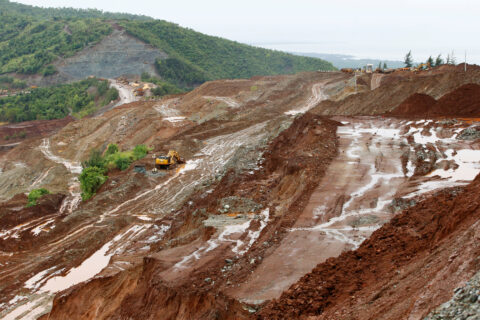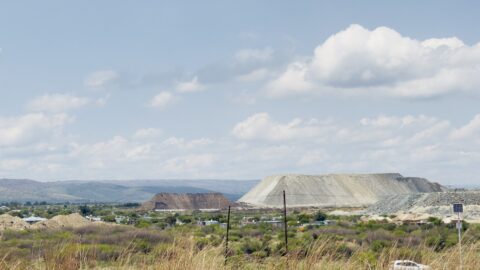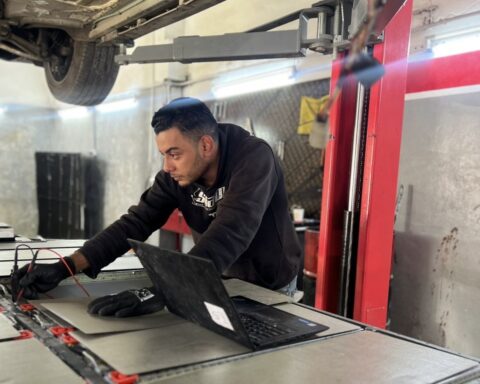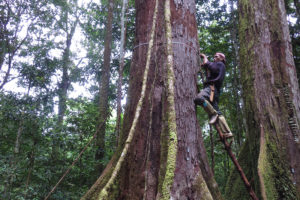Researchers have found that women and girls in the conflict-torn nation of South Sudan are facing greater health risks and worsened inequality due to the negative impacts of climate change as the country battles record-breaking heat.
The findings published ahead of International Women’s Day marked on March 8, by the World Weather Attribution (WWA) group of scientists, said February’s heatwave was made about 10 times more likely – and 2 degrees Celsius hotter – by human-caused climate change.
Last month, heatwaves in the country saw dozens of students collapse from heat stroke in the capital Juba, causing the country to close down schools for weeks, making it the second time the country has shut schools during a heatwave in the periods between February and March. It did the same when temperatures reached as high as 45 degrees Celsius in March last year.
These occurrences are unusual as the hottest temperatures of the year are not usually expected to occur as early as February, when this year’s extreme heat was observed, said the researchers.
Most schools in the country are built with iron roofs that trap heat and do not have air conditioning, creating very hot conditions for students, WWA said in a statement. High temperatures are expected to persist throughout March.
In the face of these extreme weather events, women and girls tend to suffer more as school closures disrupt children’s education and make it harder for girls to return to learning, the researchers said. Additionally, jobs and household chores typically done by women expose them to dangerous temperatures and increase the risk they will suffer heat-related illnesses, the analysis found.
Improving ventilation, planting trees and painting schools lighter colours can help reduce
temperatures in classrooms and keep schools open, said Kiswendsida Guigma, a climate scientist at the Red Cross Red Crescent Climate Centre in Burkina Faso. Adapting the school calendar and class schedules can also help avoid severe disruptions to education, he added.
A tale of two women: What climate vulnerability actually looks like
Persistent gender roles – as well as the need to care for children and a lack of other options to avoid exposure to excruciating heat – means that in South Sudan, which has high levels of poverty, today’s frequent heatwaves hit women harder, deepening the divide between genders, said Friederike Otto, WWA’s lead and a senior lecturer in climate science at Imperial College London.
She said the burning of fossil fuels has worsened extreme weather such that the people who are already struggling under unequal conditions experience the most harm. Globally women are more likely to “die during extreme weather events”, as well as experience food shortages and violence after them, she added.
The solution is to reduce these inequalities and cut planet-heating emissions from using fossil fuels, she said.
Miscarriages and stillbirths
The study, carried out by 17 researchers and scientists from universities and meteorological agencies in Burkina Faso, Kenya, Uganda, the US, the UK and elsewhere, found that the seven-day maximum heat in the South Sudan region this year would have been “extremely unlikely” if the world had not warmed by roughly 1.3 degrees Celsius compared with pre-industrial times. A similar week-long heat event would have been around 4C cooler without global warming of 1.3C, they added.
The researchers also found that the intensifying heatwaves increased the chance of miscarriage and stillbirths, making pregnancy and childbirth even more dangerous in South Sudan, which has one of the highest maternal mortality rates in the world, with 1,223 women dying for every 100,000 births.
Emmanuel Raju, one the study’s authors from the University of Copenhagen, said women and girls continue to bear disproportionate climate change impacts globally as a result of existing social inequities.
In the Global South, this “vicious cycle” often places an ongoing debt burden on women and leads to increased responsibilities and hardships such as care-giving, reduced work – particularly in the informal sector – and walking longer distances for water.
Trump’s aid cuts make Malawians more vulnerable to climate change
Intense heatwaves with temperatures as high as 40C are no longer rare events in South Sudan because of climate change, the researchers found. In today’s climate, with around 1.3C of human-caused global warming, similar extreme heat events in February can be expected about once a decade, they added.
Unless countries rapidly move away from fossil fuels, such heatwaves are expected to occur every year once warming reaches 2.6C as expected by 2100, they warned.
Sarah Kew, a WWA researcher at the Royal Netherlands Meteorological Institute, said dangerous 40C-plus heatwaves are becoming the new normal in South Sudan.
“Once rare, these episodes of high temperatures are occurring every two years,” she said, posing huge challenges for people in South Sudan and particularly women. “Without a rapid transition to a world without fossil fuels, heatwaves will continue to get even more dangerous.”
The post Women bear brunt of South Sudan’s heatwave made worse by climate change appeared first on Climate Home News.
Women bear brunt of South Sudan’s heatwave made worse by climate change
Climate Change
EU weakening of corporate sustainability rules ‘jeopardises’ climate action, critics say
The European Union’s decision to dilute its corporate sustainability rules could hurt the bloc’s efforts to fight climate change and risks rewarding companies with a poor track record, environmental NGOs and clean energy advocates say.
In a deal clinched in the early hours of Tuesday, EU leaders, the European Commission and the Parliament agreed a series of amendments to the Corporate Sustainability Due Diligence Directive (CSDDD), which will require larger companies to identify and address any environmental or human rights violations in their supply chains.
The amendments, which still need formal approval by the Parliament and EU member states, mean the due diligence requirements will apply to far fewer companies than initially targeted and maximum penalties will be reduced from 5% to 3% of a company’s annual global turnover.
In another change, the EU also scrapped a requirement for companies to publish climate transition plans setting out how they would make their business model compatible with the Paris Agreement.
The EU Commission said the changes, which follow months of corporate lobbying, US pressure and interventions by France and Germany, will remove all requirements for many smaller companies and introduce greater flexibility for larger companies, which will help to ease administrative burdens on businesses and drive investment.
But climate campaigners and clean tech industry representatives said the watered down rules were a setback for European efforts to clean up supply chains and reduce emissions.
“By deleting the climate transition plan implementation, the EU is weakening the key legislative frameworks for businesses to prepare for climate risks and global challenges that can severely affect their operations and value chains,” said Julia Otten, who works on corporate due diligence at Frank Bold, a sustainability NGO and law firm.
“This is counter-productive for businesses, weakens accountability, and jeopardises the EU’s own plans and objectives on climate and the industrial transition,” she added.
“Extremely disappointing”
Industry leaders in clean energy technologies say that the changes undermine their sector’s climate efforts and risk putting companies that prioritise sustainability at a disadvantage.
Rachel Owens, CEO of the Solar Stewardship Initiative, a multistakeholder scheme that has set out standards for what transparent and sustainable solar value chains should look like, told Climate Home News the move was “extremely disappointing”.
Requiring companies to set out their climate transition plans would have demonstrated that the production of solar panels and other renewable energy technologies and the energy they generate have much lower emissions than their fossil fuel alternatives, she said.
For Maurice Loosschilder, global head of sustainability at Signify – a multinational company that manufactures LED lighting systems that help reduce energy consumption – the removal of the climate transition plans from the law will make it more difficult to align businesses and their supply chains with the EU’s climate goals and could reduce incentives for innovation.
Because of its large size, Signify still falls under the law’s requirement. But Loosschilder said he was concerned that the company could lose its competitive edge when faced with small companies for which the same sustainability rules do not apply.
Intense lobbying
The agreement reached on Tuesday followed intense lobbying by industry and governments.
In a letter addressed to EU leaders, the US and Qatar warned that investment and energy supplies to the EU would be harmed if the CSDDD came into effect in its original form.
Documents obtained by the Amsterdam-based Centre for Research on Multinational Corporations (Somo) show how 10 major companies lobbied to dilute the regulation. This included oil and gas majors ExxonMobil, Chevron and TotalEnergies as well as metals and minerals producer Nyrstar, a subsidiary of commodity trading giant Trafigura Group.
Total Energies defended its advocacy in Brussels and in European capitals as being “in full compliance with applicable laws and regulations”. The other companies did not respond to Somo’s requests for comment.
NGO Global Witness accused EU leaders of giving in to lobbying by the fossil fuel industry.
“Major oil and gas giants will now be able to dodge their responsibility to act on [the] climate, largely thanks to intense US political and corporate pressure,” Beate Beller, a senior campaigner at Global Witness, told Climate Home News.
The EU’s about-face also weakens efforts to clean up the supply chains of technologies needed for the energy transition such as electric vehicles, batteries and solar panels.
“Clean tech cannot be ‘clean’ if the raw materials behind it are mined under weakened standards. This is what made the spirit of the CSDDD so promising: it paired climate transition plans to cut fossil-fuel dependence with robust human-rights and environmental due diligence across clean-tech supply chains,” she added.
Lower bar on supply chain oversight
The rules will now only apply to companies established in the EU with at least 5,000 employees and a net global turnover of 1.5 billion euros. It had originally applied to companies with at least 1,000 employees and turnover of 450 million euros. Member states have until July 2028 to transpose the requirements into national law.
When assessing their supply chains, companies will need to follow a risk-based approach and focus on areas that carry the biggest potential for harm. For example, an EV maker might focus on the production of the battery, which requires a range of different minerals whose extraction and processing carry high risks.
However, companies are no longer required to carry out comprehensive mapping of their direct and indirect suppliers. Instead, they will need to conduct “a general scoping exercise” based on “reasonably available information”.
Johannes Blankenbach, a senior researcher at the Business and Human Rights Centre, told Climate Home News that it is important that companies identify risks beyond their direct suppliers.
That’s because the most severe risks typically lie further up the supply chain, for example, where raw materials are sourced or extracted from the ground, he said.
In addition, harmonised rules across the EU to allow victims of harms to take companies to court have been removed, which will make it more difficult for communities to find legal remedies, Blankenbach added.
While the EU Commission said the less onerous requirements should help drive investment, Sonia Dunlop, CEO of the Global Solar Council, a trade body for the solar industry, said investors in solar farms wanted guarantees about the origin of solar panels and battery storage equipment.
“They want to know where it was made, and they want to know that it was properly made according to the highest environmental, social and governance standards,” she said, citing industry initiatives to boost supply chain transparency and standards such as the Solar Stewardship Initiative.
She said the initiative had been spurred by both the EU’s plan to tighten due diligence laws as well as industry concerns over the use of forced labour in the production of polysilicon used in solar panels in China’s Xinjiang region.
The post EU weakening of corporate sustainability rules ‘jeopardises’ climate action, critics say appeared first on Climate Home News.
EU weakening of corporate sustainability rules ‘jeopardises’ climate action, critics say
Climate Change
Analysis: What are the causes of recent record-high global temperatures?
The past three years have been exceptionally warm globally.
In 2023, global temperatures reached a new high, after they significantly exceeded expectations.
This record was surpassed in 2024 – the first year where average global temperatures were 1.5C above pre-industrial levels.
Now, 2025 is on track to be the second- or third-warmest year on record.
What has caused this apparent acceleration in warming has been subject to a lot of attention in both the media and the scientific community.
Dozens of papers have been published investigating the different factors that could have contributed to these record temperatures.
In 2024, the World Meteorological Organization (WMO) discussed potential drivers for the warmth in a special section of its “state of the global climate” report, while the American Geophysical Union ran a session on the topic at its annual meeting.
In this article, Carbon Brief explores four different factors that have been proposed for the exceptional warmth seen in recent years. These are:
- A strong El Niño event that developed in the latter part of 2023.
- Rapid declines in sulphur dioxide emissions – particularly from international shipping and China.
- An unusual volcanic eruption in Tonga in 2022.
- A stronger-than-expected solar cycle.
Carbon Brief’s analysis finds that a combination of these factors explains most of the unusual warmth observed in 2024 and half of the difference between observed and expected warming in 2023.
However, natural fluctuations in the Earth’s climate may have also played a role in the exceptional temperatures, alongside signs of declining cloud cover that may have implications for the sensitivity of the climate to human-caused emissions.
An unusually warm three years
Between 1970 and 2014, average surface temperatures rose at a fairly steady rate of around 0.18C per decade.
Set against this long-term trend, temperature increases during the period from 2015 to 2022 were on the upper end of what would be expected.
The increases seen in 2023, 2024 and 2025 were well outside of that range.
The high temperatures of the past three years reflect a broader acceleration in the rate of warming over the past decade.
However, the past three years were unusually warm, even when compared to other years in the 2010s and 2020s.
Record-breaking warmth in 2023 meant that it beat the prior warmest year of 2016 by 0.17C – the largest magnitude of a new record in the past 140 years.
The year 2024 then swiftly broke 2023’s record, becoming the first year where average global temperatures exceeded 1.5C above pre-industrial levels.
The 10 months of data available for 2025 indicates that the year is likely to be slightly cooler than 2023 – though it is possible it may tie or be slightly warmer.
The figure below shows global surface temperatures between 1970 and 2025. (The figures for 2025 include uncertainty based on the remaining three months of the year.)
It includes a smoothed average based on temperature data for 1970-2022 that takes into account some acceleration of warming – and then extrapolates that smoothed average forward to 2023-25 to determine what the expected temperature for those years would have been. (This follows the approach used in the WMO’s “state of the global climate 2024” report.)

This approach calculates how much warmer the past three years were than would be expected given the long-term trend in temperatures.
It shows that 2023 was around 0.18C warmer than expected, 2024 was a massive 0.25C warmer and 2025 is likely to be 0.11C warmer.
Researchers have identified a number of potential drivers of unexpected warmth over 2023-25. Here, Carbon Brief looks at the evidence for each one.
A weirdly behaving El Niño event
El Niño is a climate pattern of unusually warm sea surface temperatures (SSTs) in the tropical Pacific that naturally occurs every two to seven years. Strong El Niño years generally have warmer global temperatures, with the largest effect generally occurring in the months after El Niño conditions peak (when SSTs reach their highest levels in the tropical Pacific).
A relatively strong El Niño event developed in the latter half of 2023, peaking around November before fading in the spring of 2024.
This event was the fourth-strongest El Niño ever recorded, as measured according to SSTs in the Niño 3.4 region in the central tropical Pacific. However, it was notably weaker than the El Niño events in both 1998 and 2016.
This can be seen in the chart below, which shows the strength of El Niño events (red shading) since the 1980s. (The blue shading indicates La Niña events – the opposite part of the cycle to El Niño, which results in cooler SSTs in the tropical Pacific.)
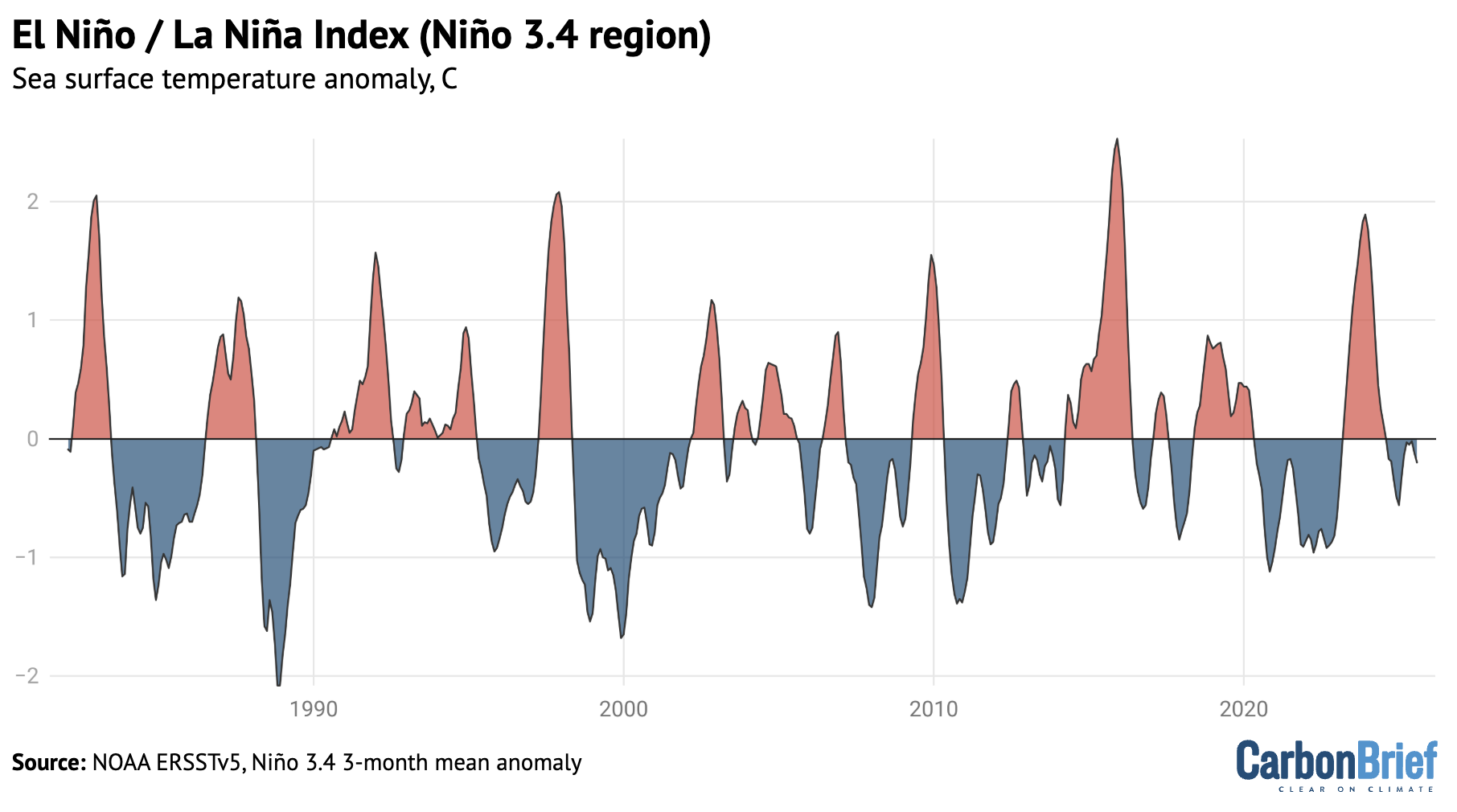
(It is worth noting that measuring the strength of El Niño events is not entirely straightforward. Other tools used by scientists to monitor changes to El Niño – such as the US National Oceanic and Atmospheric Administration’s (NOAA’s) multivariate ENSO index – show the 2023-24 event was much weaker than indicated in the Niño 3.4 dataset.)
Global surface air temperatures tend to be elevated by around 0.1-0.2C in the six months after the peak of a strong El Niño event – defined here as when SSTs in the Niño 3.4 region reach 1.5C above normal.
The figure below shows the range of global temperature change for the 12 months before and 22 months after the peak of all 10 strong El Niño events since 1950. The light line represents the average of past strong El Niño events, the dark blue line the temperature change observed during the 2023-24 event and the shaded blue area the 5-95th percentile range.
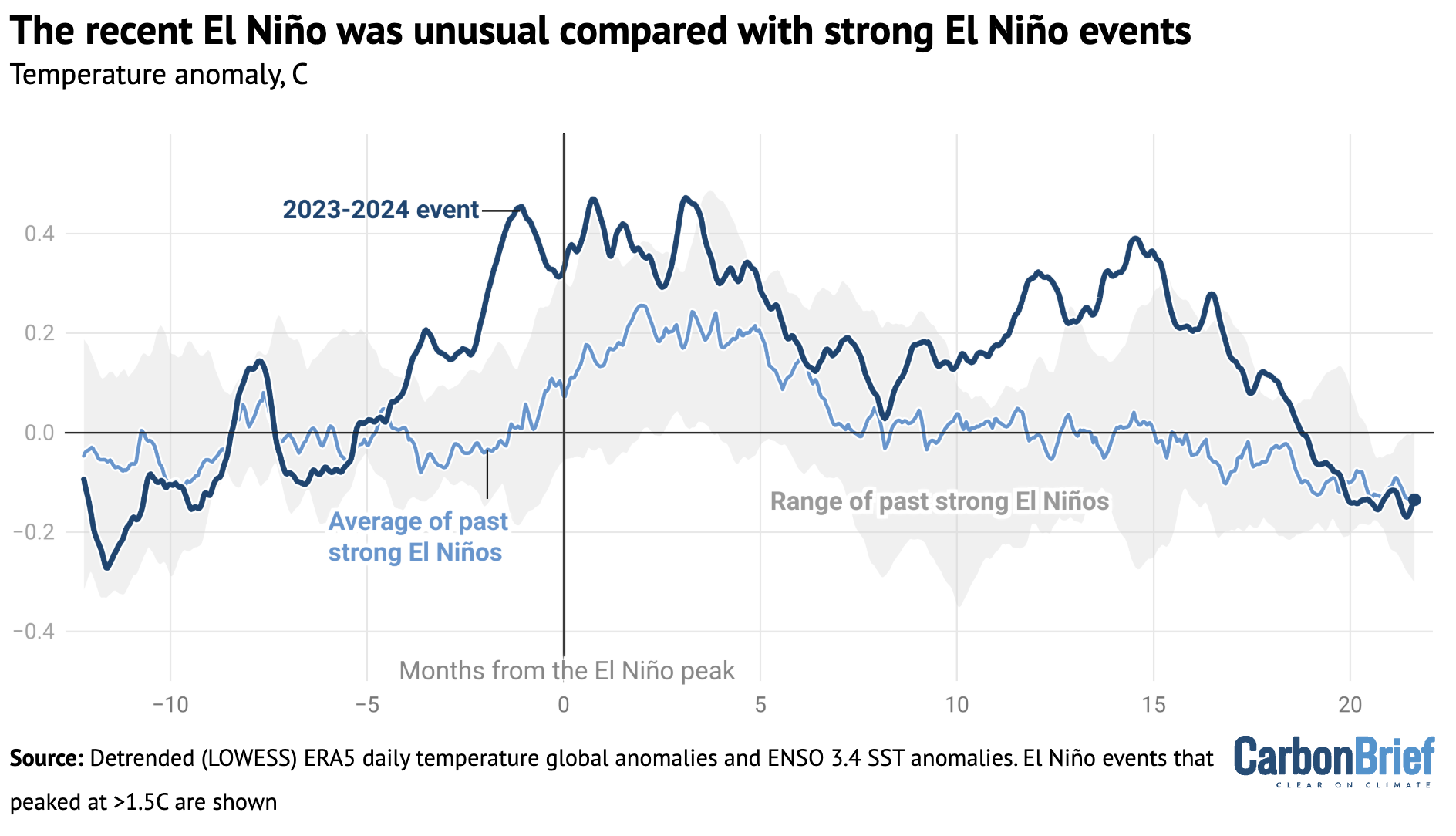
The figure shows the 2023-24 El Niño was quite unusual compared to other strong El Niño events since 1970. Global temperatures rose to around 0.4C above expected levels – which is on the high side of previous El Niños.
The heat also came early, with high temperatures showing up around four months before the El Niño event peaked. This early heat is unlike any other El Niño event in modern history and is one of the reasons why 2023’s global temperatures were so unexpectedly warm.
Global temperatures remained elevated for a full 18 months after the El Niño peaked, well after conditions in the tropical Pacific shifted into neutral conditions – and even after mild La Niña conditions developed at the end of 2024 and into early 2025.
This figure does not explain how much of this unusual heat was actually caused by El Niño, compared to other factors, but it does suggest that El Niño behaviour alone does not fully explain unusually high temperatures in recent years.
Based on the historical relationship between El Niño and global temperatures, Carbon Brief estimates that El Niño contributed a modest 0.013C to 2023 temperatures and a more substantial 0.128C to 2024 temperatures, albeit with large uncertainties. (See “methodology” section at the end for details.)
However, it is possible that this 2023 estimate is too low. There are some suggestions in the literature that 2023-24 El Niño’s early warmth may have been caused by the rapid transition out of a particularly extended La Niña event. There are indications that temperatures have spiked in similar situations further back in the historical temperature record.
Falling sulphur dioxide emissions
Sulphur dioxide (SO2) is an aerosol that is emitted into the lower atmosphere by the burning of coal and oil. It has a powerful climate cooling effect – Carbon Brief analysis shows that global emissions of SO2 have masked about one-third of historical warming.
Global SO2 emissions have declined around 40% over the past 18 years, as countries have increasingly prioritised reducing air pollution, including through the installation of scrubbers at coal plants.
These declines have been particularly concentrated in China, which has seen a 70% decline in SO2 emissions since 2007. In addition, a rule introduced for international shipping in 2020 by the International Maritime Organization (IMO) has resulted in an 80% decline in the sulphur content of shipping fuel used around the world.
The decline of SO2 emissions is shown in the figure below.

Shipping in particular has been suggested as a potential culprit for recent temperatures, given that ships emit SO2 over oceans where the air tends to be cleaner and so emissions have a bigger effect.
Seven of the eight studies that have explored the temperature impact of the IMO regulations have suggested a relatively modest effect, in the range of 0.03-0.08C. However, one study – led by former NASA scientist Dr James Hansen – calculated a much stronger effect of 0.2C that would explain virtually all the unusual warmth of recent years.
The figure below shows Carbon Brief’s estimate of the global average surface temperature changes caused by the low-sulphur shipping fuel rules, using the estimates produced by all eight studies. The central estimate (dark blue line) is relatively low, at around 0.05C, but the uncertainty range (light blue shading) across the studies remains large.
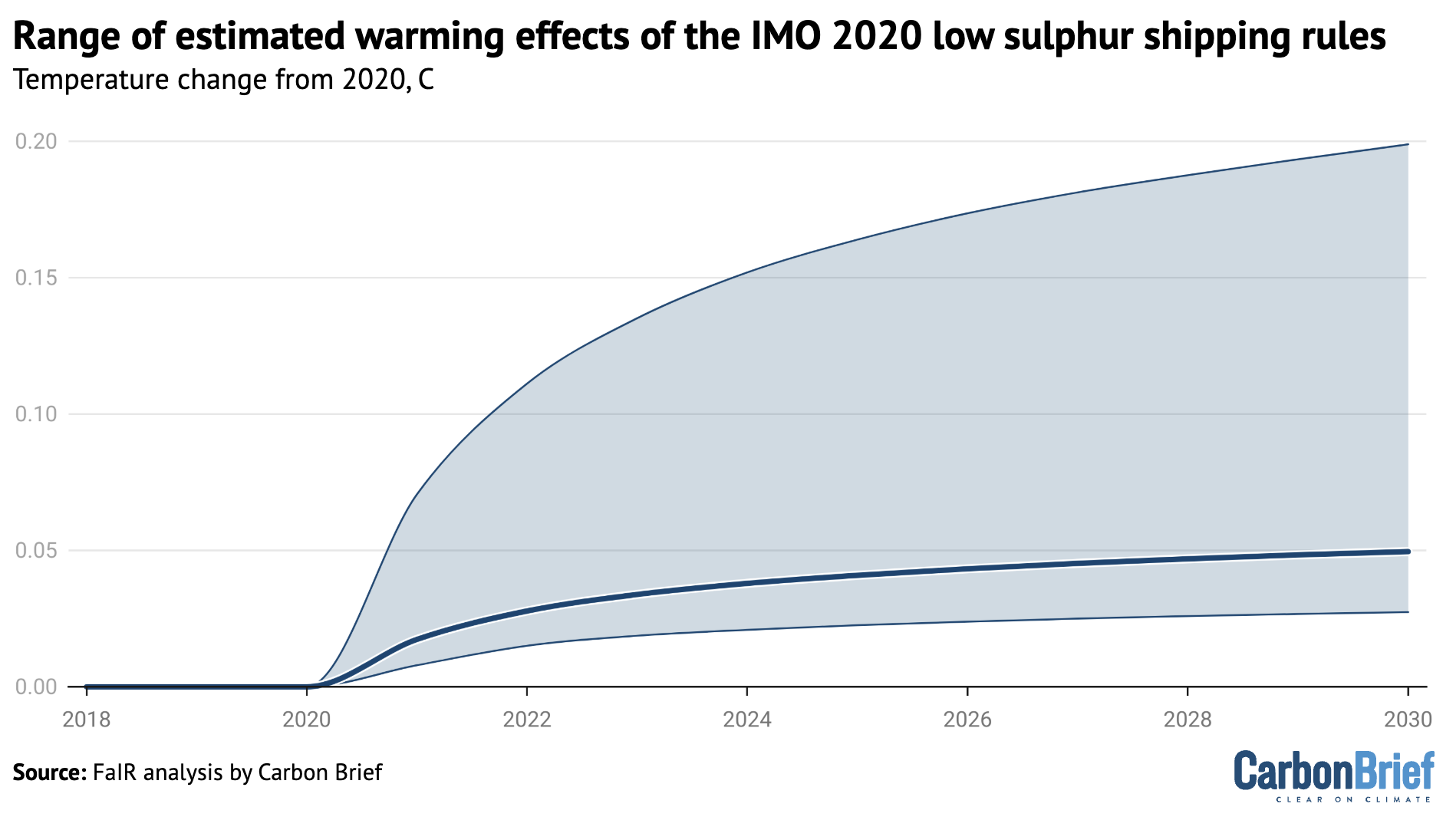
Overall, Carbon Brief’s analysis finds that around 0.04C of warming over 2020-23 and 0.05C of warming over 2020-24 can be attributed to SO2 declines from shipping and other sources.
However, this approach might slightly overstate the effects of SO2 on the exceptional temperatures of the past three years, as shipping and other SO2 declines would have had some effect on 2021 and 2022 as well.
It is also worth noting that the total effects of SO2 declines on global temperatures have been considerably larger and are estimated to be responsible for around one-quarter of all warming since 2007.
However, these SO2 decreases occurred over a long period of time and do not clearly explain the recent spike in temperatures.
An unusual volcanic eruption in Tonga
In early 2022, the Hunga Tonga-Hunga Ha’apai underwater volcano erupted spectacularly, sending a plume 55km into the atmosphere. This was by far the most explosive volcanic eruption since Mount Pinatubo erupted in 1991.
This was a highly unusual volcanic eruption, which vaporised vast amounts of sea water and lofted it high into the atmosphere. Overall, around 146m metric tonnes of water vapour ended up in the stratosphere, which is the layer of the atmosphere above the troposphere.
Water vapour is a powerful greenhouse gas. While it is short-lived in the lower atmosphere, it can stick around for years in the stratosphere, where it has a significant warming effect on the climate.
The figure below shows the concentration of water vapour in the stratosphere between 2005 and mid-2025. It shows how the 2022 eruption increased atmospheric concentrations of the greenhouse gas by around 15%. More than half the added water vapour has subsequently fallen out of the upper atmosphere.

Most early studies of the Hunga Tonga-Hunga Ha’apai volcano focused specifically on the effects of stratospheric water vapour. These tended to show strong warming in the lower stratosphere and cooling in the middle-to-upper stratosphere, but only a slight warming effect on global surface temperatures of around 0.05C.
Hunga Tonga-Hunga Ha’apai had much lower sulphur emissions than prior explosive eruptions, such as Pinatubo and El Chichon. However it put 0.5–1.5m tonnes of sulphur into the stratosphere – the most from an eruption since Pinatubo.
Studies that included both sulphur and water vapour effects tend to find that the net effect of the eruption on surface temperatures was slight global cooling, concentrated in the southern hemisphere.
By using the estimates published in a 2024 study published in Geophysical Research Letters, which used the FaIR climate emulator model, Carbon Brief estimates that the Hunga Tonga-Hunga Ha’apai eruption cooled global surface temperatures by -0.01C in 2023 and -0.02C in 2024.
This suggests that the eruption was likely only a minor contributor to recent global surface temperatures.
A stronger-than-expected solar cycle
The source of almost all energy on Earth is the sun. Over hundreds of millions of years, variations in solar output have a big impact on the global climate.
Thankfully, over shorter periods of time the sun is remarkably stable, helping keep the Earth’s climate habitable for life. (Big changes – such as ice ages – have more to do with variations in the Earth’s orbit than changes in solar output.)
However, slight changes in solar output do occur – and when they do, they can influence climate change over shorter periods of time. The most important of these is the roughly 11-year solar cycle, which is linked with the sun’s magnetic field and results in changes in the number of sunspots and amount of solar energy reaching Earth.
The figure below shows a best-estimate of changes in total solar irradiance since 1980, based on satellite observations. Total solar irradiance is a measure of the overall amount of solar energy that reaches the top of the Earth’s atmosphere and is measured in watts per metre squared.
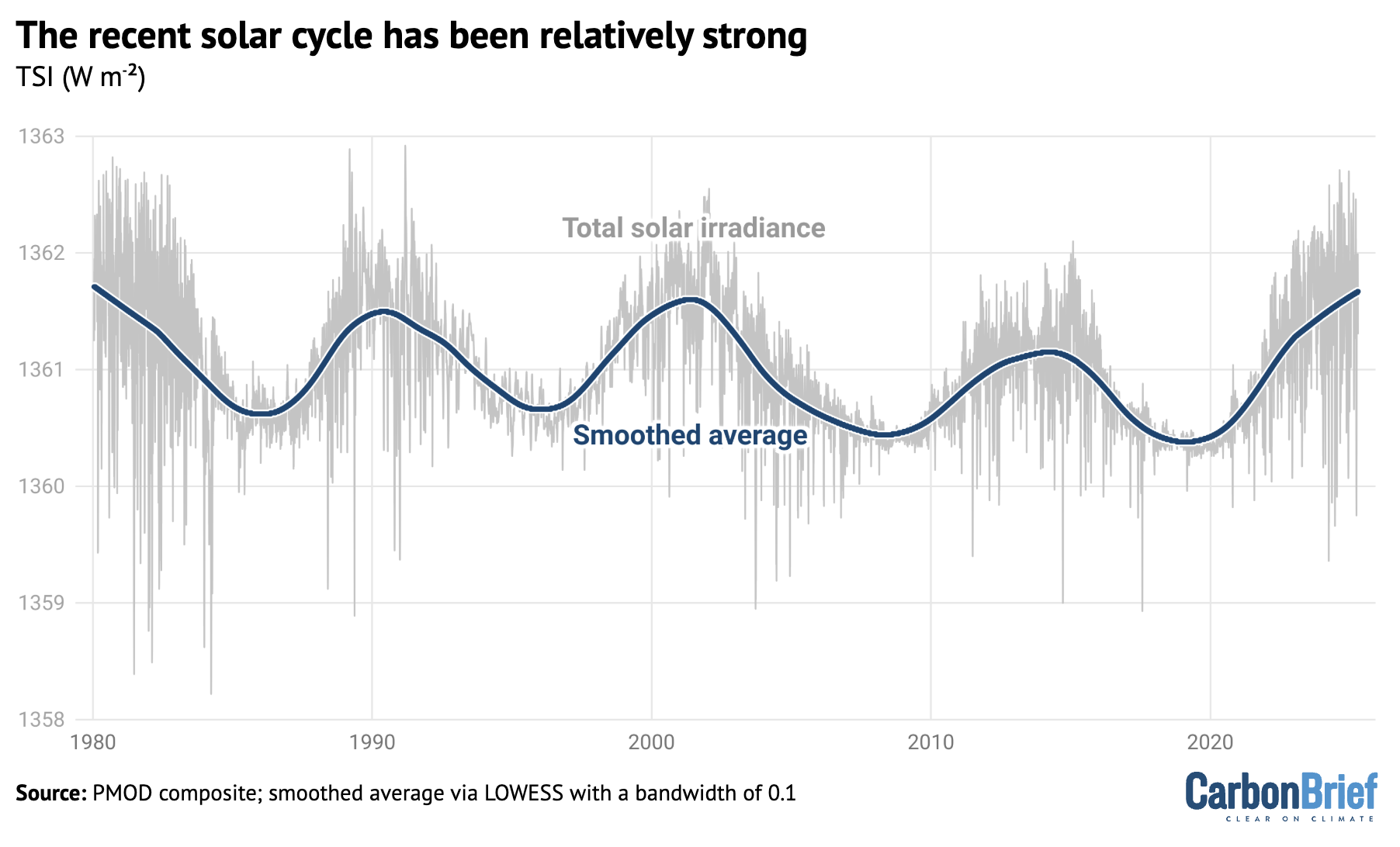
The 11-year solar cycle is relatively modest compared to the sun’s total output, varying only a few watts per metre squared between peak and trough – amounting to around 0.01% of solar output. However, these changes can result in variations of up to 0.1C in global temperatures within a decade.
The most recent solar cycle – solar cycle 25 – began around 2020 and has been the strongest solar cycle measured since 1980. It was stronger than most models had anticipated and likely contributed to around 0.04C global warming in 2023 and 0.07C in 2024.
Putting together the drivers
By combining earlier estimates of different factors contributing to 2023 and 2024 global surface temperatures, about half of 2023’s unusual warmth and almost all of 2024’s unusual warmth can be effectively explained.
This is illustrated in the figure below, which shows the five different factors discussed earlier – El Niño, shipping SO2, Chinese SO2, the Hunga Tonga-Hunga Ha’apai volcano and solar cycle changes – along with their respective uncertainties.
The sum of all the factors is shown in the “combined” bar, while the actual warming compared to expectations is shown in red.
The upper chart shows 2023, while the lower one shows 2024.
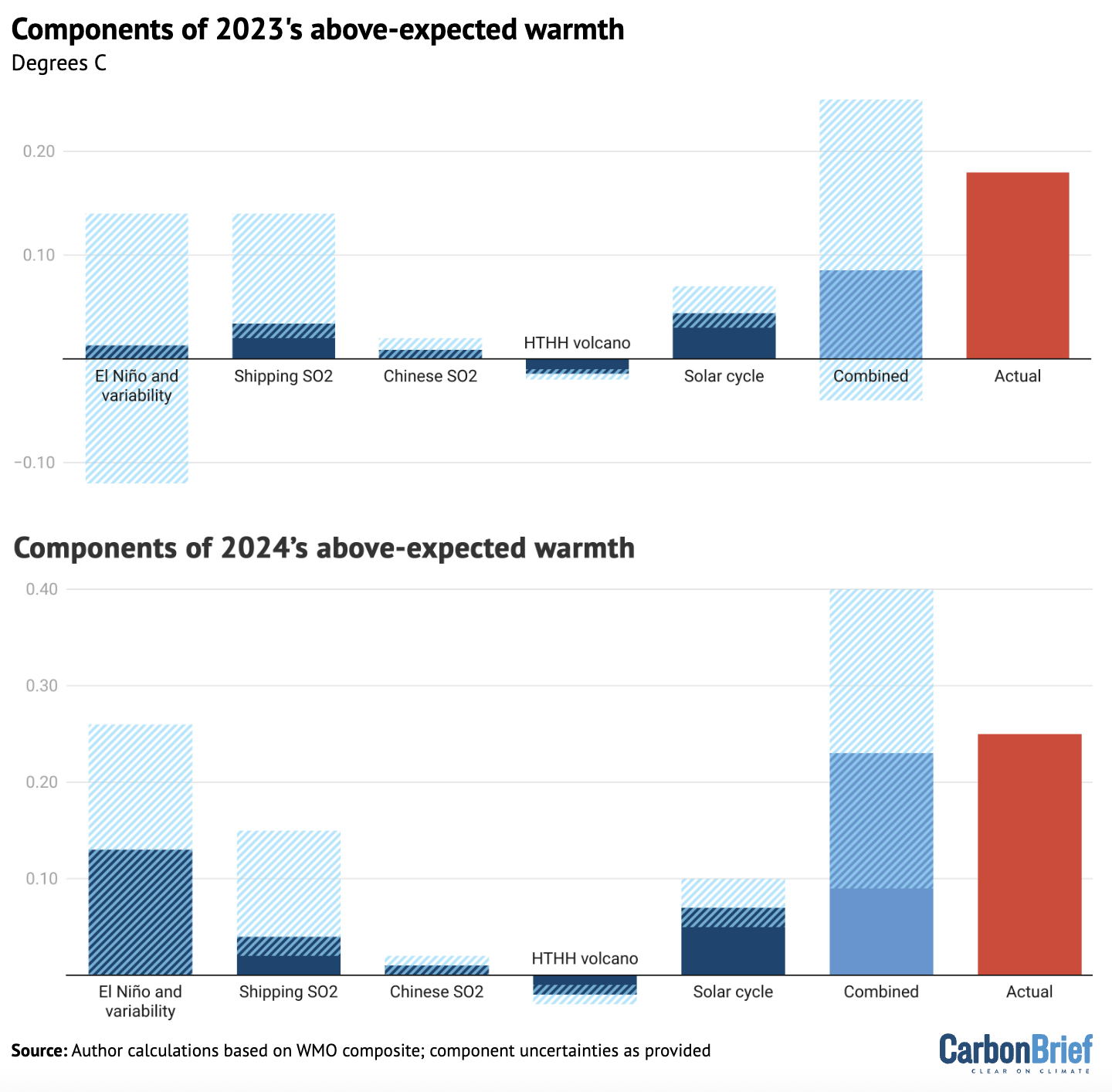
It is important to note that the first bar includes both El Niño and natural year-to-year variability; the height of the bar reflects the best estimate of El Niño’s effects, while the uncertainty range encompasses year-to-year variability in global temperatures that may be – at least in part – unrelated to El Niño.
The role of natural climate variability
Large natural variability to the Earth’s climate is one of the main reasons why the combined value of the different drivers of expected warmth in 2023 has an uncertainty range that exceeds the observed warming – even though the best-estimate of combined factors only explains half of temperatures.
Or, to put it another way, there is up 0.15C difference in global temperatures year-on-year that cannot be explained solely by El Niño, human-driven global warming, or natural “forcings” – such as volcanoes or variations in solar output.
The figure below shows the difference between actual and expected warming in the global temperature record for every year in the form of a histogram. The vertical zero line represents the expectation given long-term global warming and the other vertical lines indicate the warming seen in 2023, 2024 and 2025.
The height of each blue bar represents the number of years over 1850-2024 when the average global temperature was that far (above or below) the expected level of warming.
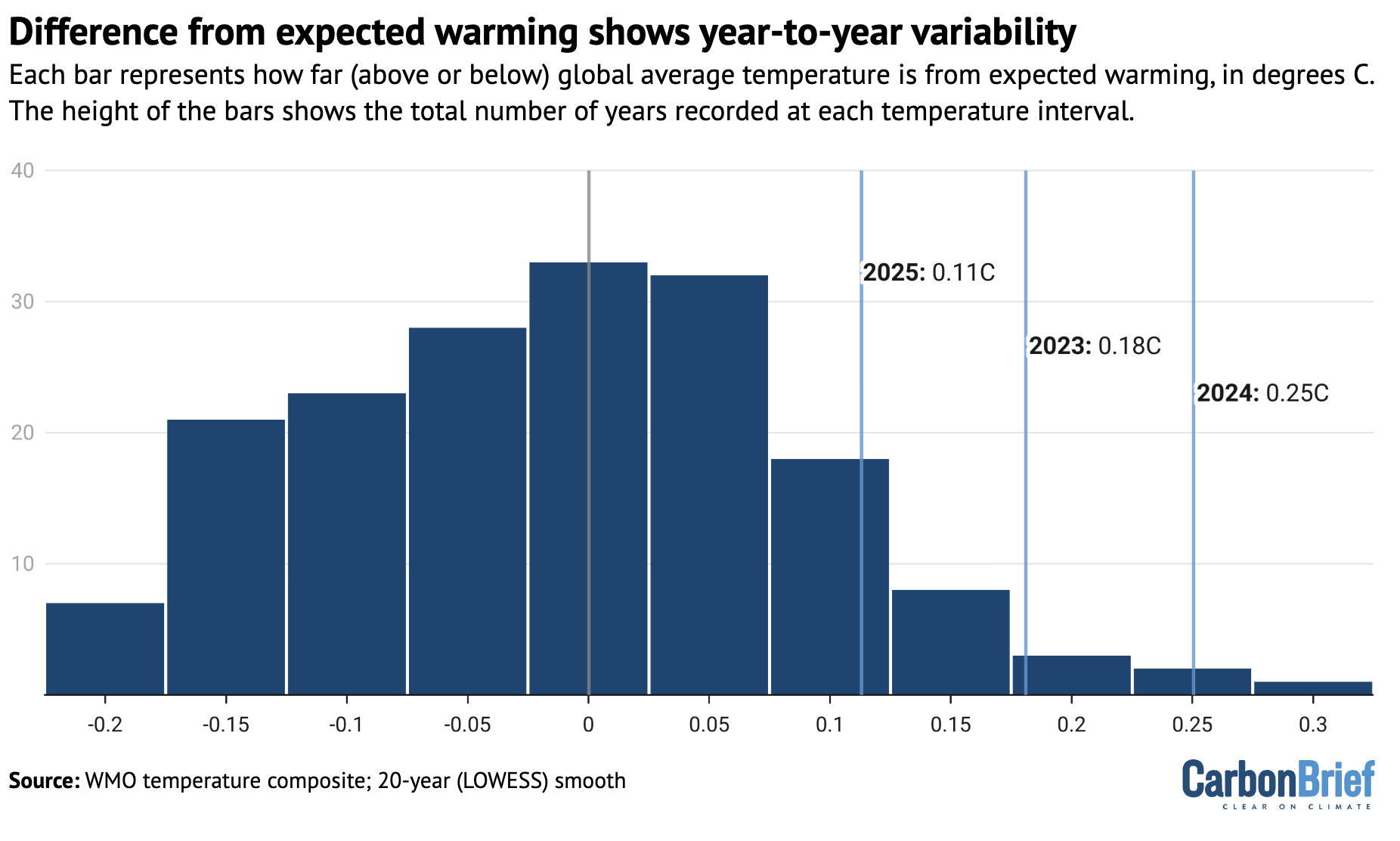
Based on the range of year-to-year variability, temperatures would be expected to spike as far above the long-term trend as they did in 2023 once every 25 years, on average. The year 2024 would be a one-in-88 year event, whereas 2025 would be a less-unusual, one-in-seven year event.
These likelihoods for the past three years are sensitive to the approach used to determine what the longer-term warming level should be.
In this analysis, Carbon Brief used a local smoothing approach (known as locally estimated scatterplot smoothing) to determine the expected temperatures, following the approach used in the WMO “state of the climate 2024” report.
This approach results in a warming of 1.28C in 2023 and 1.30C in 2024, against which observed temperatures are compared.
Other published estimates put the longer-term warming in 2024 notably higher.
Earlier this year, the scientists behind the “Indicators of Global Climate Change” (IGCC) report estimated that human activity caused 1.36C of recent warming in 2024. They also found a slightly lower overall warming level for 2024 – 1.52C, as opposed to the WMO’s 1.55C – because they looked exclusively at datasets used by IPCC AR6. (This meant estimates from the Copernicus/ECMWF’s ERA5 dataset were not included.)
Based on climate simulations, the IGCC report finds the likelihood of 2024’s warmth to be a one-in-six year event and 2023’s a one-in-four event.
Using the same assumptions as the IGCC, Carbon Brief’s approach calculates that 2024 would be a less-common, one-in-18 year event.
However, the IGCC estimate of current human-induced warming is based on the latest estimates of human and natural factors warming the climate. That means that it already accounts for additional warming from low-sulphur shipping fuel, East Asian aerosols and other factors discussed above.
Therefore, the results from these two analyses are not necessarily inconsistent: natural climate variability (including El Niño) played a key role – but this came in addition to other factors. Natural fluctuations in the Earth’s climate alone would have been unlikely to result in the extreme global temperatures seen in 2023, 2024 and 2025.
A cloudy picture
Even if unusual recent global warmth can be mostly attributed to a combination of El Niño, falling SO2 emissions, the Hunga Tonga-Hunga Ha’apai volcano, solar cycle changes and natural climate variability, there are a number of questions that remain unanswered.
Most important is what the record warmth means for the climate going forward. Is it likely to revert to the long-term average warming level, or does it reflect an acceleration in the underlying rate of warming – and, if so, what might its causes be?
As explained by Carbon Brief in a 2023 article, climate models have suggested that warming will speed up. Some of this acceleration is built into the analysis presented here, which includes a slightly faster rate of warming in recent years than has characterised the period since 1970.
But there are broader questions about what – beyond declining SO2 and other aerosols – is driving this acceleration.
Research recently published in the journal Science offered some potential clues. It found a significant decline in planetary reflectivity – known as albedo – over the past decade, associated with a reduced low-level cloud cover that is unprecedented in the satellite record.
The authors suggest it could be due to a combination of three different factors: natural climate variability, changing SO2 and other aerosol emissions and the effects of global warming on cloud reflectivity.
Natural climate variability seems unlikely to have played a major role in reduced cloud cover, given that it was relatively stable until 2015. However, it is hard to fully rule it out given the relatively short satellite record.
Reductions in SO2 emissions are expected to reduce cloud reflectivity, but the magnitude of the observed cloud reflectivity changes are much larger than models simulate.
Models might be underestimating the impact of aerosols on the climate. But, if this were the case, it would indicate that climate sensitivity might be on the higher end of the range of model estimates, because models that simulate stronger aerosol cooling effects tend to have higher climate sensitivity.
Finally, cloud cover might be changing and becoming less reflective as a result of warming. Cloud responses to climate change are one of the largest drivers of uncertainty in future warming. One of the main reasons that some climate models find a higher climate sensitivity is due to their simulation of less-reflective clouds in a warming world.
The Science study concludes that the 2023 heat “may be here to stay” if the cloud-related albedo decline was not “solely” caused by natural variability. This would also suggest the Earth’s climate sensitivity may be closer to the upper range of current estimates, it notes.
Methodology
Carbon Brief built on work previously published in the IGCC 2024 and WMO state of the global climate 2024 reports that explores the role of different factors in the extreme temperatures in 2023, 2024 and 2025.
The impact of El Niño Southern Oscillation (ENSO) on the temperatures was estimated using a linear regression of the annual mean global temperature anomaly on the Feb/Mar Niño 3.4 index. This resulted in an impact of −0.07C, 0.01C and 0.13C for 2022, 2023 and 2024 respectively (with a 95% confidence interval of ±0.13 ºC).
It is important to note that the uncertainties in the ENSO response estimated here also incorporate other sources of unforced internal (modes of variability in other basins such as AMV), and potentially some forced variability. The bar in the combined figure is labelled “El Niño and variability” to reflect this.
For details on calculations of the temperature impact of shipping and Chinese SO2 declines, see Carbon Brief’s explainer on the climate impact of changing aerosol emissions.
Solar cycle 25 was both slightly earlier and slightly stronger than prior expectations with a total solar irradiance anomaly of 0.97 watts per metre squared in 2023 relative to the mean of the prior 20 years. This resulted in an estimated radiative forcing of approximately 0.17 watts per metre squared and an estimated global surface temperature increase of 0.07C (0.05C to 0.10C) with a one- to two-year lag based on a 2015 study. Thus, the impact on 2023 and 2024 is around 0.04C and 0.07C, respectively (+/- 0.025C). This is a bit higher warming than is given by the FaIR model, as the 2015 study is based on global models that have ozone responses to the UV changes, which amplifies the temperature effects a bit.
The Hunga Tonga-Hunga Haʻapai volcanic eruption added both SO2 and water vapour to the stratosphere (up to 55km in altitude). The rapid oxidation of SO2 to sulphate aerosol dominated the radiative forcing for the first two years after the eruption. As a result, the net radiative forcing at the tropopause was likely negative; −0.04 watts per metre squared and −0.15 watts per metre squared in 2022 and 2023, respectively, implying a temperature impact of -0.02C (-0.01C to -0.03C) calculated using the FaIR model.
The post Analysis: What are the causes of recent record-high global temperatures? appeared first on Carbon Brief.
Analysis: What are the causes of recent record-high global temperatures?
Climate Change
US set to push fossil fuels under its G20 presidency
As the United States takes the reins of the G20 and makes economic growth the top priority, the Trump administration is expected to use its year in charge to promote fossil fuels while shifting the focus away from climate action and clean energy.
With Washington assuming the presidency of the group of the world’s largest economies for the first time since 2009, US Secretary of State Marco Rubio opened with a notably blunt statement, declaring that “unlocking affordable and secure energy supply chains” would be one of three key themes, alongside deregulation and new technologies.
Although renewables are widely recognised as central to building a cost-effective and reliable energy system, that is not going to be the message from the US G20 presidency, experts said.
“They clearly want to push a fossil fuels-oriented agenda and one that’s also critical of green and climate technologies,” said David Waskow, director of the International Climate Initiative at the World Resources Institute (WRI).
Attack on South Africa
Washington’s rhetoric marks a clear shift from the tone set by the past year’s G20 host, South Africa, which placed climate action – particularly climate finance and the escalating impacts of global warming – at the centre of its diplomacy.
The urgency of climate action and a commitment to limit global warming to below 1.5C were recognised in a final declaration endorsed by leaders attending November’s summit in Johannesburg, which the US boycotted.
After the official handover of the presidency, the Trump administration mounted an all-out attack on South Africa with whom its relations were already sour. All pre-existing content was scrubbed from the G20 official website and replaced with a picture of the US president alongside the message “the best is yet to come”.
Then, in an unprecedented step, Rubio unilaterally announced the exclusion of South Africa from next year’s G20 meetings. In addition to repeating unfounded allegations of racism by the South African government against the country’s white Afrikaner minority, the US State Secretary attacked South Africa’s G20 as an exercise in “radical agendas” – including climate change – that ignored the US objections.
Rejecting the accusations, South Africa’s Minister of International Relations and Cooperation Ronald Lamola told Rubio the country remained “open to dialogue”, but “would not seek your approval to our path”.
US push for fossil fuel expansion
Max Yoeli, a senior US research fellow at Chatham House, said that, while the South African presidency focused on solidarity and equality, the US will likely pursue its own national interests with a more transactional approach at the G20.
On energy, nearly a year since his return to office, President Trump has left no doubt about his administration’s strong backing for US fossil fuels, while labelling clean energy a “scam” and taking steps to actively halt its rollout across the country.
The new US national security strategy, published last week, said that restoring American energy dominance in oil, gas, coal and nuclear is a top strategic priority. The expansion of energy exports would “deepen relationships with allies while curtailing the influence of adversaries”, it added. The US is already the world’s largest producer and leading exporter of both oil and gas.
Yoeli said the Trump administration’s domestic regulatory agenda is very tilted to expanding drilling to boost hydrocarbons, while adding barriers to wind and solar deployment and slowing utility-scale clean energy rollout. “It is pretty clear they will pull in the same direction [at the G20],” he noted.
G20 tensions on energy and climate
What the US government could achieve concretely at the G20 is unclear. WRI’s Waskow said the Trump administration could try and insert pro-fossil fuel language and remove references to climate change in the official statements and communiques that are the main outputs of G20 summits.
But he predicted most other G20 member governments would mount a strong pushback. “It’s really quite unimaginable that others would be ready to go along with that agenda,” Waskow added.
The other six most advanced economies, including European countries, Canada and Japan, remain committed to tackling climate change and cutting greenhouse gas emissions – at least on paper.
Meanwhile, the BRICS group of the largest emerging economies called for a stronger response to climate change and reaffirmed their commitment to “just” energy transitions at a leaders’ summit last July. Despite this, the joint declaration also singled out fossil fuels’ “important role in the world’s energy mix”.
Against this geopolitical backdrop, it is possible that countries might be unable to reach consensus on a joint G20 declaration and the US could try to insert its opposition to climate action into a chair’s summary, Waskow said.
Chatham House’s Yoeli said that, with the Trump administration very focused on perceptions of its behaviour, it will be interesting to see how it balances rhetoric with concrete outcomes at the G20.
The post US set to push fossil fuels under its G20 presidency appeared first on Climate Home News.
-
Climate Change4 months ago
Guest post: Why China is still building new coal – and when it might stop
-
Greenhouse Gases4 months ago
Guest post: Why China is still building new coal – and when it might stop
-
Climate Change2 years ago
Spanish-language misinformation on renewable energy spreads online, report shows
-

 Greenhouse Gases2 years ago
Greenhouse Gases2 years ago嘉宾来稿:满足中国增长的用电需求 光伏加储能“比新建煤电更实惠”
-
Climate Change Videos2 years ago
The toxic gas flares fuelling Nigeria’s climate change – BBC News
-

 Climate Change2 years ago
Climate Change2 years ago嘉宾来稿:满足中国增长的用电需求 光伏加储能“比新建煤电更实惠”
-

 Carbon Footprint2 years ago
Carbon Footprint2 years agoUS SEC’s Climate Disclosure Rules Spur Renewed Interest in Carbon Credits
-
Climate Change2 years ago
Why airlines are perfect targets for anti-greenwashing legal action

